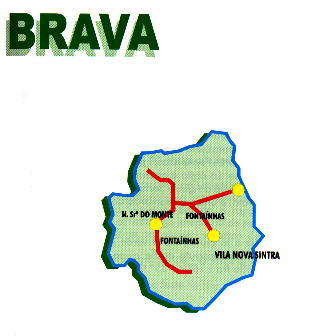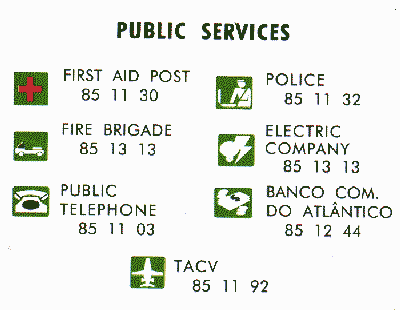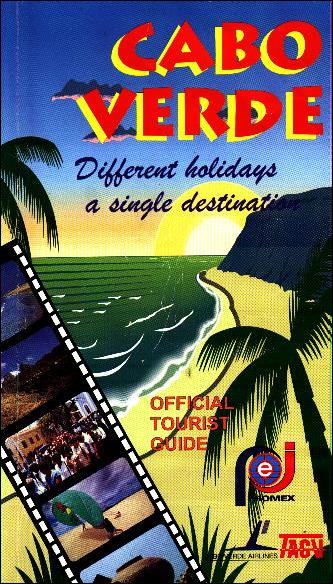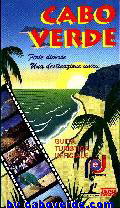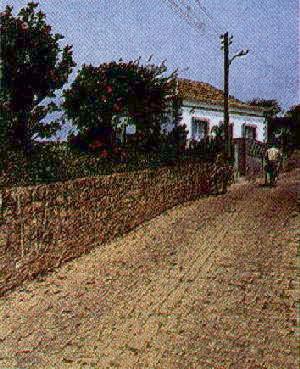
Location
The island of Brava is located in the extreme Southeast of the leeward group of the Archipelago, with an elliptic configuration, it has a surface of 64 km2 and the maximum length of 9 km East-Westward. lt is 20 km away from the island of Fogo and from this viewpoint you can see four small islets where the fishermen go from time to time.
Brava is the smallest island of the Archipelago with the exception of the
uninhabited Santa Luzia. lt is very mountainous and its highest point is
Monte Fontainhas. Deep and abrupt valleys contrast with its high peaks. The coastline is very rugged, forming many bays such as: Furna, Ancião, Fajã d'Água and Somo. Evidence of the volcanic past of the island can be seen in Fundo Grande; a crater preserved by time.
Due to its altitude, Brava is the dampest and the most green of all the islands
and due to and its abundance of flowers makes it known as "ilha das flores"
(island of flowers).
The medium temperature oscillates between 16 and 26°C
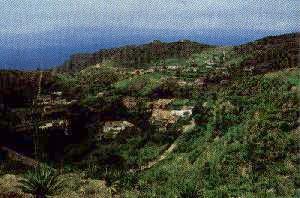
History
It was discovered in 1462 and its began to become populated after 1680. Due to the eruption of the volcano of Pico, in the nearby island of Fogo, its inhabitants all relocated to Brava. By the end of the XVIII century the New Bedford and Rhode Island whaleboats started to use the island as a supply stop in the mid Atlantic.
Little by little the men from Brava, with their fame for being excellent mariners, find work aboard these whaleboats. But because the living conditions on these boats were very hard, the Cape Verdeans started to look for jobs on land, mainly in Massachusetts, thus commencing the emigration to the United States of America, where still today there is the greatest Cape Verdean community abroad. Therefore, it is not by chance that in Brava, English is more widely spoken and the greater part of the commercialized products come from the United States.
Besides the remittances of money from the country of Uncle Sam for families still residing in Brava, the economy of the island is based on agriculture and fishing. Coffee, sugar-cane, manioc, corn and potatoes are the main agricultural produds, while the sea, rich in fish and sea-food (lobster, limpet and conch), gives work to hundreds of people.
Brava is also known as the island of Nhô Eugenio, a nome famous in the Cape Verdean poetry and music. Eugenio Tavares, either writing in Partuguese or in Creole is, without any doubt, the undisputed master of the "morna". lt was on this island as well that, due to its intense relationship with the United States of America, Cape Verdean Pratestantism originated.
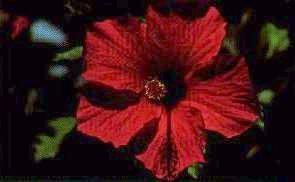
Cultural Events
Just like all the other islands the popular festivities are all throughout the year and they are celebrated with great enthusiasm. However, it is the "Juninas" festivities that attract most of the attention.
6th of JANUARY -
This is the island where the Day of the Three Wise Men is commemorated everywhere.
l3th ofJUNE -
Saint Anthony starts the "Juninas" festivities.
24th ofJUNE -
The feast of St. John is one of the main events on the cultural calendar of the island. Besides being the most traditional one, this feast coincides with the day of the Patron Saint of the island, St. John the Baptist, and is a unique experience of gathering with emigrants from all over the world, particularly from the United States, as well as visitors from the other islands.
29th ofJune -
St. Peter continues the programme of feasts.
AUGUST AND SEPTEMBER -
In various places there are commemorations of feasts like the ones in honour of St. Paul and S. Palinho.
Food and Drink
Fresh and diverse types of fish may be enjoyed no matter where you are in the island. However, we recommend shellfish, of a firstclass quality, and "xerén com capa". Typical dishes are multiplied during the festivities.
The emigrants visiting from the United States, adapt the pumpkin and apple pie to their homeland replacing the ingredients with local fruits such as mango and squash.
Entertainment and Sport
The visitor can spend many pleasurable hours on the island, just
walking or driving in the towns or in the surrounding countryside. The scenery is beautiful and magnificent panaramic views can be had from a number of viewing points. The entire atmosphere is one of relaxation, for from the hustle and bustle of the modem world.
BRAVA is known as the island of the flowers and without doubt the colourful gardens with the sweet fragrances of the hibiscus, the bougainville, the jasmine and others are a beautiful sight.
Relaxing on the beaches or swimming in the extraordinary lagoons sheltered from the wind are other attractive alternatives.
This is also a fisherman's paradise.
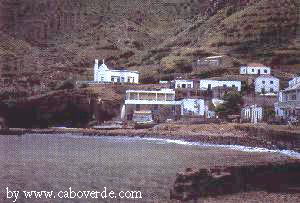
Places to Visit
A must for any visitor to BRAVA is NOVA SINTRA, a beautiful town that got its nome from the Sintra in Portugal, due to the similarities between them.
It is situaled at the base of a circle of mountains that at one time had been the rovine of an old crater, the eastern side of which disappeared probably
due either to erosion or an earthquake. The layoul of the streets, the typical houses and the masses of flowers make Nova Sintra a delight to visit.
The garden that stands out most is that named after the poet Eugenio
Tavares. A stone carved map can be seen there and a plaque dedicated specially to the poet.
Without a doubt, Nova Sintra is the most beautiful town in the whole of Cabo Verde.
Visit to FONTE DA VIRGEM
FONTE DA VIRGEM, easily reached by foot, is a beautiful place and although the precious rain is not at all abundant, the local people have designed a method of growing their crops in small terraces that are irrigated by water coming from the springs. Water that is very rich in fluorile and bicarbonate.
It is also fascinaling to see the beautiful exotic birds with blue wings and red beaks.
NOVA SINTRA Viewing point
When leaving NOVA SINTRA, at us highest part and going towards NOSSA SENHORA DO MONTE there is a left turn about 2Km down the road from where
a trulymagnificent view of the whole town and even the sea can be had.
A Visit to FAJA D'ÁGUA and SORNO
This is a very picturesque route with lots of beatiful scenery.
FAJA D'AGUA is a small village with a very priviledged location: a bay sheltered from the north east winds at the foot of the mountain. Years ago the whaling boats used to land here. Nearby is a lovely sandy beach. Real pleasure can be had just walking from the village towards the mountain and admiring the vegetation, the local houses and the scenery.
The airport is not too far away.
On the way back the road passes by SORNO, which is another beautiful spot.
Befare reaching FIGUEIRA, the road goes to the left and then down into SORNO which is by a small, sheltered and very picturesque bay.
A few hundred meters further on, a rocky peak emerges, which looks like a volcanic needle.
Along the coastline the crops growing on the ridges catch the eye.
FURNA
From NOVA SINTRA the road slopes deeply down to FURNA, which is a small fishing port. The actualbay itself is only a few hundred meters in diameter.
The local church overlooks the sea.
NOSSA SENHORA DO MONTE
This is a typical mountain village. Because of the droughts the houses here have cisterns so they can store water the whole year round. The scenery is well worth seeing. The road to CACHAÇO and MATO GRANDE is peaceful and calm and once the views to had are quite spectacular.
